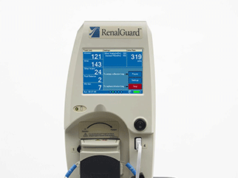Two US Food and Drug Administration-cleared medical devices designed to remove potential vessel-blocking debris particles from the bloodstream during aortic valve replacement—EmbolX (Edwards LifeSciences) and CardioGard (CardioGard Medical)—did not significantly reduce overall number of brain infarcts over standard surgical procedure, according to a study presented at the American College of Cardiology’s 66th Annual Scientific Session (ACC; 17-19 March, Washington, DC, USA).
Overall, about two-thirds of study participants experienced the study’s primary endpoint, central nervous system infarcts, as measured clinically or with diffusion-weighted magnetic resonance imaging (MRI), at seven days after the operation. That proportion was roughly the same for patients randomised to receive a standard surgical aortic cannula (a tube through which a patient’s blood flows during heart surgery), the Embol-X device or the CardioGard device.
“Despite the fact that debris was captured—which was the mechanism by which these devices are intended to work—there was no difference in the primary endpoint,” says Michael Mack, medical director for cardiovascular surgery at Baylor Health Care System and the study’s lead author. “However, the vast majority of infarcts were only detectable by post-operative MRI, with fewer than 10% of patients exhibiting clinical symptoms. Moreover, trends with respect to the volume of brain infarction suggest that embolic protection device recipients were less likely to have larger infarcts. This may be important, as the risk of symptomatic stroke increases with infarct volume.”
The results echo those of a recent trial assessing the use of a comparable medical device with a related procedure, transcatheter aortic valve implantation (TAVI), which also did not show a strong benefit in terms of MRI-detected brain infarcts.
Embol-X and CardioGard are designed to address the risk of TAVI-related brain infarcts by removing debris from the bloodstream before the particles can travel to the brain. Embol-X is a filter that is intended to capture debris as it flows through the artery. CardioGard is a suction-based device designed to remove debris and air bubbles from the blood while it is being pumped through a heart-lung machine during open-heart aortic valve surgery.
The researchers enrolled 383 patients undergoing surgical aortic valve replacement at 18 sites in North America. Patients were randomly assigned to receive either the standard aortic cannula (132 patients), Embol-X (133 patients) or CardioGard (118 patients). The researchers performed separate analyses comparing each of the groups treated with the embolic protection device to those receiving only the standard cannula (controls). Because the trial began with randomising Embol-X or control, the first 12 control patients served as controls for Embol-X only and 120 patients were common to both control groups. Clinicians tracked damage to the central nervous system using diffusion-weighted MRI scans, neurocognitive assessments and clinical stroke diagnoses.
The study revealed that the devices did function as intended, capturing debris in 99.1% of patients treated with Embol-X and 75.8% of patients treated with CardioGard. In addition, the results showed a significant reduction in in-hospital delirium at day seven post-surgery in patients receiving the CardioGard device and a trend toward reduced delirium in patients receiving Embol-X.
The proportion of patients with clinical strokes based on physical findings by seven days did not differ among patients randomized to receive CardioGard, Embol-X or standard aortic cannula. There were fewer severe clinical strokes observed in the embolic protection device groups compared to controls in the first three days after surgery, although the study was not designed to assess the clinical significance of this observed trend. Neurocognitive outcomes at 90 days were similar between groups, with the exception of executive function decline, which was reduced in patients receiving the Embol-X device.
Further study could help to clarify whether these findings may translate into significantly better health outcomes for patients.
“There is suggestive evidence that there may be a benefit, despite not meeting the primary endpoint of this trial,” Mack says.
A key limitation of the trial is that it was not large enough to definitively detect differences in the incidence of clinical stroke, which was analysed as a secondary outcome. The trial was stopped early after an interim analysis showed it was not likely to meet its primary endpoint and, thus, enrolling more patients would likely be futile. It is also possible that diffusion-weighted MRI is an overly sensitive tool for measuring damage to the brain, hampering researchers’ ability to distinguish between blood vessel blockages that cause actual neurological deficits from those that do not, according to researchers.










